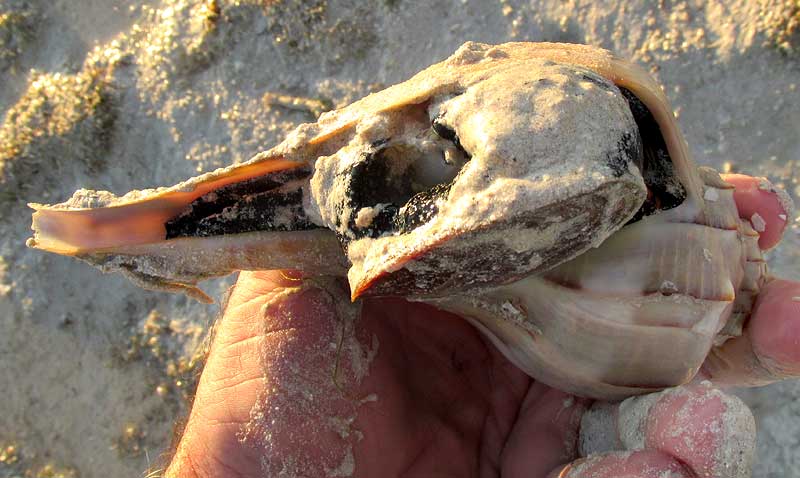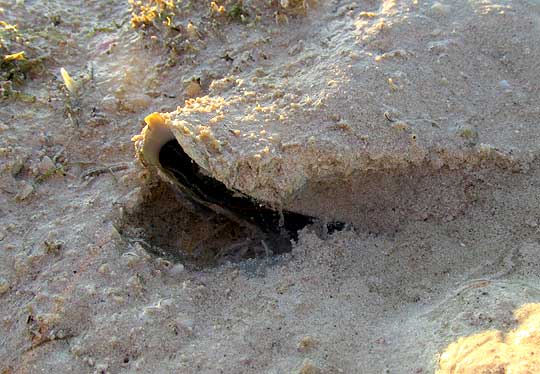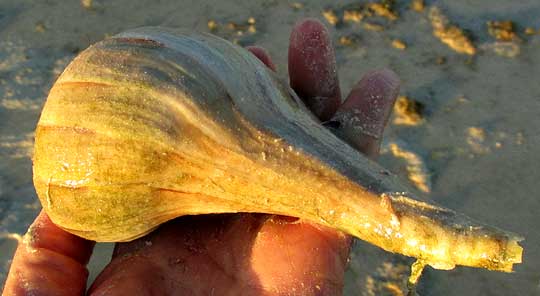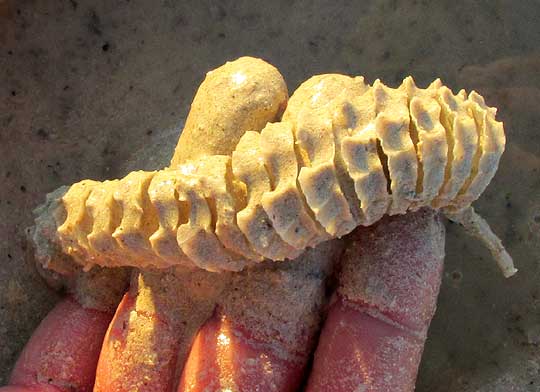Excerpts from Jim Conrad's
Naturalist Newsletter

from the February 22, 2015 Newsletter issued from Río Lagartos, on the Yucatan Peninsula's northern coast (~N21.60°, ~W88.16°), Yucatán state, MÉXICO
LIGHTNING WHELK
At dawn during an exceptionally low tide we weren't the only ones wandering around on mudflats that normally are covered with water; several other local folks widely separated from one another slogged back and forth, carrying buckets. Rayo told me they were digging "conchas," to eat. The word "conchas" means "shells," but here the word also applies to the living mollusks producing what northerners normally think of as seashells. Then Rayo spotted the very thing the others were looking for, the nose of a shell barely poking from the mud, shown below:

Being careful not to hurt the creature, I excavated mud from around the shell and was surprised that it turned out to be so large. At the top of this page you can see the extracted muddy creature with its body slowly retracting into its shell. The shell's top side is shown, glowing with dawn's golden light, is shown below:

Amid soupy mud left pooled in the depression from which the mollusk had been removed was a string of egg cases our mollusk had been producing, shown below:

Volunteer identifier Bea in icy Ontario just bought herself a used Peterson field guide to sea shells, so off these pictures went to Bea, who soon determined that we had a Lightning Whelk, BUSYCON PERVERSUM*.
The "perversum" in the name derives from the fact that this species' shell makes a "left handed" spiral, which seems a little perverse in a world of mostly "right handed" spiraling things. Apparently this was special enough that Native Americans once used these shells in religious ceremonies.
But native Americans also harvested them for food, just like the local folks that morning, because Lightning Whelks are highly edible. Also, at one time people used the shells as scrapers, gouges and even cups and bowls. When you read how whelks were harvested in the past, and see how they're being dug up even today, it's amazing that the species survives.
Lightning Whelks are described as inhabiting bottoms of shallow bays in sand or mud near Shoalgrass or Turtlegrass meadows -- ours were near Shoalgrass meadows -- from the western Atlantic at North Carolina in the US, south through the Gulf of Mexico to the Yucatan Peninsula.
Lightning Whelks mainly feed on bivalves such as oysters, clams, and scallops, and in turn are fed upon by gulls, crabs, and other whelks. Their strings of egg-bearing capsules normally range from about 11 to 33 inches (27 to 83 cm) long, with each string holding up to 145 capsules, and each capsule holding 20 to 100 eggs, though only about 8 to 13 eggs in each capsule hatch.